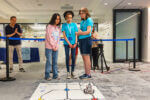A simple search about encouraging young girls to be confident in school often leads to articles warning against overpromising their potential. These articles outline “right” and “wrong” things to say to ensure our daughters develop “reasonable” expectations about their futures. But after reading countless stories of women who defied the odds in science, technology, engineering, and math (STEM), I’m compelled to challenge this perspective and emphasize the importance of encouraging middle school girls to pursue STEM—especially at an age when their perceptions of these fields are still forming.
For centuries, women were told they were too weak-minded, too incapable to learn, work, and receive credit alongside men in STEM fields like medicine, mathematics, and computer programming. Elizabeth Blackwell, the first woman to graduate from a U.S. medical school, was rejected by ten medical schools before being admitted to Geneva College through what was intended as a practical joke—only to finish at the top of her class. Then there’s Katherine Johnson, a brilliant mathematician who helped calculate the path of the first human spaceflight in the U.S. Yet, she had to tenaciously fight to be admitted to meetings with her male colleagues.
These women, and many others, didn’t just defy expectations—they shattered them, proving that the limitations placed on them were imposed, not inherent. Their perseverance has paved the way for our daughters to be equal contributors to STEM industries today and in the future.
Gender Gap in STEM Fields
Despite tremendous progress, a gender gap exists in U.S. STEM fields, with women filling only 35% of STEM occupations. This disparity is even more significant in cutting-edge fields like artificial intelligence, where women make up just 22% of the workforce. Increasing women’s interest in STEM careers early on is crucial, as it would expand the pool of talented minds, bringing new perspectives and different skill sets to address major global issues, from curing diseases to safeguarding the environment.
Understanding Barriers for Middle School Girls in STEM
Several barriers prevent girls from fully embracing STEM, and some of them may surprise you. What’s important to remember is that these are merely obstacles that can be overcome.
How Language Shapes Gender Stereotypes in STEM
One critical factor contributing to the disparity is how children perceive STEM. Research from the Association for Psychological Science shows this gap begins in early childhood, where linguistic cues can shape how children perceive science. These cues can lead children to view certain STEM occupations as an identity (being a scientist) rather than an action (doing science). As a result, many children, particularly girls, don’t see themselves fitting into these seemingly exclusive groups.
Lack of Female Role Models
Not only are females underrepresented in STEM, but they are also not often in the spotlight—unlike actresses, musicians, or politicians. This lack of exposure to remarkable female figures in STEM makes it difficult for young girls to find a role model to look up to.
Confidence Gap
A study examining mathematics self-efficacy in boys and girls revealed an astonishing difference in confidence levels. More than one thousand 9th graders participated in this study, and despite earning similar grades on the same standardized test, the girls reported lower self-esteem and were less likely to amplify their performance. This confidence gap can significantly influence their continued interest in STEM.
Limited Access to Engaging STEM Activities
STEM programs aren’t as prevalent as other extracurricular activities like sports, dance, or music. With fewer or less popular options, students are likelier to opt for a different activity, leaving STEM off their radar.
Breaking Barriers and Creating a Supportive Environment
Parents have a crucial role to play in changing the narrative when it comes to STEM. Starting in early childhood and continuing throughout your daughter’s education, you can take steps to foster her exploration and interest in STEM-related topics. You have the power to spark her curiosity about the world, encourage her to expand her interests, and build her confidence in her abilities. Here are some ways you can help your daughter:
Create opportunities for hands-on learning.
Engaging in fun and interesting activities can help your daughter see herself as someone who “does science” rather than “being a scientist.” Simple at-home experiments, like showing how static electricity in a balloon can lift small objects or growing your own crystals, can create meaningful and memorable learning experiences.
Plan science-related field trips and experiences.
Visiting science and natural history museums, planetariums, zoos, botanical gardens, and aquariums and enrolling in STEM-based camps and clubs can expand your daughter’s horizons and ignite new interests in all kinds of subjects. These venues offer hands-on exhibits and interactive experiences that can deepen and extend what she learns in school, making science come alive in an exciting way.
Discover real-life female STEM superheroes.
Looking up to a role model can be incredibly inspiring for young girls interested in STEM. Books and movies like “Hidden Figures” and “Women in Science: 50 Fearless Pioneers Who Changed the World” highlight the remarkable contributions of women in these fields. Sharing their stories can show your daughter that women have and continue to make significant, positive impacts on the world through STEM.
Integrate STEM into play.
Incorporate STEM principles into playtime, such as designing mazes, setting up a dominoes cascade, or solving a Rubik’s Cube.
Encourage participation in school activities.
Many schools, like K12-powered online schools, offer extracurricular activities focusing on STEM topics, such as specialized clubs, innovation challenges, robotics competitions, and job shadowing. These activities help provide hands-on experiences that make learning both fun and engaging.
Highlight real-world applications.
It can sometimes be challenging for students to see how topics like chemistry and algebra relate to the real world. This is your chance to show them how STEM fields benefit people, drive innovation, and solve major world problems. From renewable energy engineers and marine biologists to environmental scientists and robotics engineers, STEM careers apply the principles learned in classes like chemistry and algebra to make a significant impact.
Be supportive.
Creating a supportive environment that nurtures her curiosity and interests is important as she engages in STEM activities and explores how they impact the world around her. Encourage her to ask questions and learn together with her. Remind her that challenges and setbacks are valuable parts of the learning process and will help her to grow into a resilient, capable adult. Demonstrating how exciting STEM can be—not just for her but for you as well—can keep her motivated to continue exploring and learning.
Prepare for a STEM Pathway in High School and College
If your daughter shows interest in STEM and related careers, high school is the perfect time to help her strengthen her knowledge and skills. Many schools, including K12-powered online schools, offer specialized career pathways that include career-focused courses, hands-on and project-based learning, opportunities to earn college credit, and guidance with resumes and interview prep. Participating in a career pathway can give her a head start on an incredible career before she even finishes high school.
Girls and STEM: Mentorship and Role Models
Mentorship plays a key role in a student’s STEM journey. K12’s partnership with Tallo, a comprehensive career development platform, offers a valuable resource for students seeking a job or internship—an important step in finding a STEM mentor or role model. Studies show that having a female role model in STEM can significantly influence students’ career choices. In fact, female high school seniors are more likely to enroll in male-dominated STEM college programs when their schools actively work to reduce gender stereotypes and promote equality in academic abilities.
Join K12 in Encouraging and Supporting Middle School Girls to Embrace STEM
Let’s remind our daughters that they have the skills, perspectives, and resilience to make a profound impact—whether in STEM or any other field. By helping them explore their interests and nurturing their curiosity, we can empower them to try new activities and courses with confidence. Bolstering their self-efficacy will make a huge difference in the path they choose after high school.
We are raising the next generation of innovators, problem-solvers, and leaders. Now is the time to open their minds to a world of endless possibilities. Let’s take action today to guide and encourage our daughters along their journey in STEM, supporting them every step of the way.























































































































